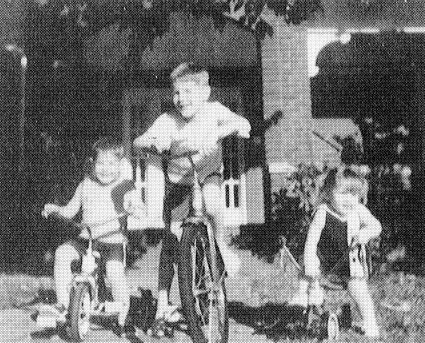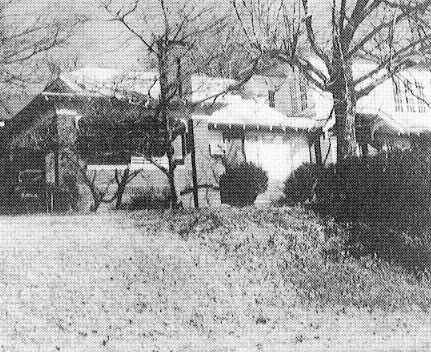If These Walls Had Ears (18 page)
Read If These Walls Had Ears Online
Authors: James Morgan

On the morning of August 17, Pat told Ruth that she needed to go to the shopping center after summer school that day,. There
was nothing unusual about Pat’s story. This was a new shopping center that had just opened a mile or so west of Holly Street.
The downtown merchants were already feeling the pinch as the city moved steadily westward—a trend that had begun with the
development of Pulaski Heights—and shoppers responded to the novelty of the new centers. Pat would be home late, she said,
but not to worry.
Late that afternoon, Billie happened to be upstairs in the attic playroom when the phone rang. Joyce was there with him. Billie
answered, and it was Pat. He talked with her for a few minutes, his voice sounding strained.
When he hung up, his face was pale. He went downstairs to find Ruth.
Many nights, I lie awake studying the shadows in my bedroom. Beth and I sleep in the middle room downstairs. On those nights
when I can’t doze off, I drift back to all that’s happened inside
these
very walls, the walls within the walls of the house itself. Once I get started, it’s not hard to summon up the characters
and then to lie there watching them unobserved, like Scrooge in those heartbreaking visits to his Christmases past:
Charlie Armour opens the doors to his wardrobe and carefully hangs up his suit. Jessie, still talking, crawls under the covers
of the sleigh bed across the room. Suddenly, the person in bed becomes Grandma Jackson, who died with her head in that very
spot. Charlie stands holding a coffee cup. Then the bed is replaced by easy chairs. A new air conditioner hums in the middle
window as Ruth reads by lamplight. Billie comes in and says something to her. She begins to weep. This room is the precise
spot where Ruth Murphree’s heart was broken.
She was sitting in the den, reading. I can imagine Billie taking a deep breath and telling himself he had to approach her
very calmly, and then going in with that forced calmness that immediately unnerves anyone who encounters it. “That was Pat
on the phone,” Billie said. “She and Larry got married today.” Thirty-five years later, Ruth marks August 17, 1959, as the
day that “broke our hearts.”
Billie didn’t show it as much as Ruth did. Ruth shrieked and sobbed and paced the floor of the den while Billie sat in his
black recliner in front of the air conditioner, trying to calm her: “Now, Mommy…” Pat had called from Texarkana, Texas.
Pat and Larry had driven there to get married by a justice of the peace. Billie had told them to come on home, that they would
all make the best of it.
On the three-hour drive from Texarkana, Pat and Larry were nervous over what they’d done. “I wished it was twenty years later,”
Pat says, remembering that trip back to Little Rock. She knew she had hurt her parents, but she felt that things would work
out all right—
if
she could just avoid this homecoming at 501 Holly.
Ruth was on the phone, calling Larry’s parents, calling Martha. Martha recalls that Ruth was in tears. Through the sobbing,
she managed to get out what Pat had done. Martha and Jerry had only one car, and Ruth urged her and Jerry to come over the
minute
Jerry got home from medical school. Martha says when she and Jerry got to Holly Street, “Mother was hysterical. Daddy was
very, very stressed and hurt.” Billie was sitting in his chair, and Ruth was pacing and screaming: “We’ve got to get an annulment;
that’s all we can do! We’ve
got
to get this thing
annulled!
What’ll the neighbors think!”
For the Murphrees, it was the culminating moment of the postwar years, years in which old ideals had steadily given way to
new realities. This situation, a middle-class sixteen-year-old girl running away from a life that had gone off track, running
off to marry an eighteen-year-old boy—well, it was the pushiness of the Negroes and the rebelliousness of Elvis all wrapped
up in one. It was
sex—
was Pat pregnant? Pat denied it then and does today, but everybody assumed she was. Those assumptions finally put the kibosh
on Ruth’s talk about annulment. The only thing more humiliating than a married sixteen-year-old daughter was a pregnant,
unmarried
sixteen-year-old daughter. Besides, Billie felt strongly that if you’d had sex, you needed to be married. And if you were
married, you should
stay
arried.
They were all on the cusp of a new era, the 1960s, and this was just a little taste of it. In two years, the censor board
would be gone. In four years, U. S. Presidents would no longer be safe on the nation’s streets. In six years, women’s skirts
would be scandalously short and men’s hair outrageously long. There would be a divisive war. There would be rebellious young
people living together in communes, smoking more than cigarettes. God forbid, but there would soon come a time when Elvis
Presley would look tame.
They knew none of that, of course, that night as Ruth wailed her heartsick cry and Billie suffered in silence, in that middle
room of the home they’d worked so hard to keep airtight against all manner of rising tides. The home as sanctuary—what a laugh.
In the end, the ultimate flood came from the inside—from their own tears.
Jerry had sedatives with him. He gave some to Ruth and put her to bed.
Quarrel
and
Pilgrimage

Mark, Scott, and Lori Grimes. Their family ushered in a new era, one in which change became a more frequent visitor
.

By the late sixties, 501 Holly was feeling its age. And so was Billie Murphree, who told Ruth the Lee Street hill had become
too steep to mow
.
White Walls
1960
 1966
1966I
’m happy to report that, for the Murphrees, there was life beyond that terrible August night in the den. The following spring,
they welcomed two grandchildren—Martha’s son and Pat’s daughter into the rowdy mix of the Murphree clan. They bought a place
on Lake Hamilton in Hot Springs, where they and their sprawling extended family began spending vacations and parts of weekends,
commuting the hour to the lake after Sunday-morning church, and then, after an afternoon of swimming and boating and water
skiing, driving back to Little Rock in time for BTU and the evening sermon. They watched Joyce, their own baby, grow into
a responsible teenager (though not without her
own
conflicts with her mother), and they watched Martha and Pat settle into marriage and motherhood (though not without Billie’s
occasional reprimands because their skirts were too short). They, especially Ruth, continued to work on the house. She had
the front casement windows in the music room replaced by a picture window like those in the living and dining rooms. She also
decided, after contending with years of dust and noise, to install wall-to-wall carpeting downstairs. She chose a beige wool
with the very latest sculpted design.
Ruth says the reason they moved was that Billie finally got sick of mowing that terrace, that Lee Street hill. He’d taken
to tying a rope around his lawn mower and tethering it to a tree, so that if he slipped, the mower wouldn’t careen into the
path of a car. It was, of course, ridiculous. After two decades, the hill had become just too steep. “I want a flat lot,”
Billie told Ruth one day. It was music to her ears. They decided to build a house farther west, in a newer, more fashionable
part of town.
By the time they did, those of us in their children’s generation had already launched our own pilgrimages. Our restless journeys
would take many forms and would branch in wild new directions, but the destination would always be the same.
Some of us would think we’d reached it at a house on Holly Street.
Surely there’s meaning in the fact that the first two families in this house lived here a total of forty-three years, while
the rest of us,
six
families in all, have come and mostly gone over a period of only twenty-nine.
I don’t pretend to know precisely why that is. All I know is that Billie Murphree’s generation seems to have been the last
to regard change as something not to be
sought.
Billie came home from World War II arid stayed at one job for three decades. He was married to one woman for more than half
a century. He and Ruth moved just three times during all those years. They bought cemetery plots and picked out their coffins
when they were in middle age. And Billie, because of his sideline real estate business, turned out to be a millionaire.
Those days seem gone forever. To me, though, it sometimes feels like something epic has been lost—some sweep, some heroic,
poetic willingness to stand against outside forces—only to be replaced by something that’s festered up from deep inside us
and caused us to
run,
and to keep on running, shifting directions whenever the wind blows. It feels as though the search has become indistinguishable
from whatever it is we’re searching for.
In house terms, I know from experience that this restlessness has its own palette. It’s pale, neutral, not nearly as passionate
as you might think.
My oldest friend has had the same telephone number and post office box since we graduated front college almost thirty years
ago. Since he married in 1969, he and his wife—the same wife—have lived in one apartment and two houses, the latter for the
past fifteen years. My friend claims he’s had to fill out an entire Rolodex just to keep track of me. I hate when lie says
that, because it’s so close to true. And yet I think I’m more nearly typical of American life—certainly of our generation—than
he is. “In the United States,” Alexis de Tocqueville wrote in 1835, “a man builds a house in which to spend his old age, and
he sells it before the roof is on.” I’ve read that the average American lives in sonic thirteen residences during his lifetime.
This is about twice the rate in England and France, four times the rate in Ireland, and half the rate for me—so
far.
People who analyze such things attribute American rootless ness to several factors—a greater likelihood of divorce, for one;
a wider geographic dispersal of economic opportunity, for another. Those strike me as mere mile-stones on a circle. Tocqueville
suspected a deeper cause—that our classless society gives the average American more opportunity, which produces in him “anxiety,
fear, and regret.” As a result, he’s always searching, always looking over his shoulder, always changing his plans “and his
abode.”
And when he changes his abode, he paints it beige or white so it’ll sell or rent more easily the next time.
I’ve always loved color, loved its power to express the soul. And yet it took me years to sense what the expectation of moving
was doing to the quality of my life. In 1968, after I finished graduate school, my wife and I moved to Kansas City; where
I went to work for Hallmark. We rented an apartment, had a son, rented another apartment, then a house, then yet another apartment.
All of them had white walls. I changed jobs, discovered the magazine business. The moment I got into it, I started angling
for the next magazine, the next position. We bought a house, my first—an almost-new house. The only color in it was the gold
shag carpeting and our icy blue drapes.
